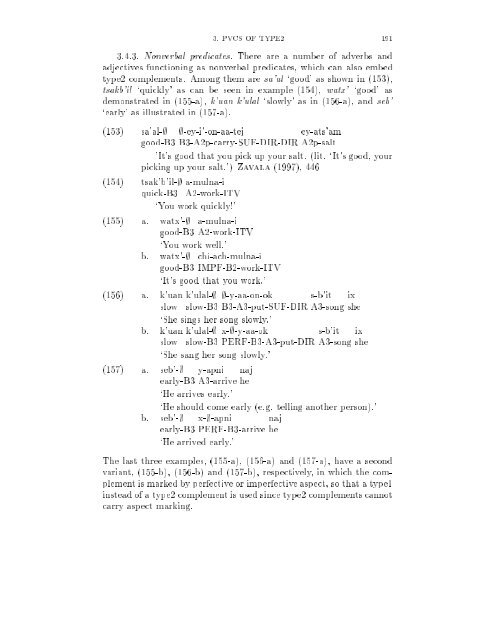Perception verb complements in Akatek, a Mayan language
Perception verb complements in Akatek, a Mayan language
Perception verb complements in Akatek, a Mayan language
Create successful ePaper yourself
Turn your PDF publications into a flip-book with our unique Google optimized e-Paper software.
3. PVCS OF TYPE2 191<br />
3.4.3. Non<strong>verb</strong>al predicates. There are a number of ad<strong>verb</strong>s and<br />
adjectives function<strong>in</strong>g as non<strong>verb</strong>al predicates, which can also embed<br />
type2 <strong>complements</strong>. Among them are sa'al `good' as shown <strong>in</strong> (153),<br />
tsakb'il `quickly' as can be seen <strong>in</strong> example (154), watx' `good' as<br />
demonstrated <strong>in</strong> (155-a), k'uan k'ulal `slowly' as <strong>in</strong> (156-a), and seb'<br />
`early' as illustrated <strong>in</strong> (157-a).<br />
(153) sa'al-; ;-ey-i'-on-aa-tej<br />
ey-ats'am<br />
good-B3 B3-A2p-carry-SUF-DIR-DIR A2p-salt<br />
'It's good that you pick upyour salt. (lit. `It's good, your<br />
pick<strong>in</strong>g up your salt.') Zavala (1997), 446<br />
(154) tsak'b'il-; a-mulna-i<br />
quick-B3 A2-work-ITV<br />
`You work quickly!'<br />
(155) a. watx'-; a-mulna-i<br />
good-B3 A2-work-ITV<br />
`You work well.'<br />
b. watx'-; chi-ach-mulna-i<br />
good-B3 IMPF-B2-work-ITV<br />
`It's good that you work.'<br />
(156) a. k'uan k'ulal-; ;-y-aa-on-ok s-b'it ix<br />
slow slow-B3 B3-A3-put-SUF-DIR A3-song she<br />
b.<br />
`She s<strong>in</strong>gs her song slowly.'<br />
k'uan k'ulal-; x-;-y-aa-ok<br />
s-b'it ix<br />
slow slow-B3 PERF-B3-A3-put-DIR A3-song she<br />
`She sang her song slowly.'<br />
(157) a. seb'-; y-apni naj<br />
early-B3 A3-arrive he<br />
`He arrives early.'<br />
`He should come early (e.g. tell<strong>in</strong>g another person).'<br />
b. seb'-; x-;-apni naj<br />
early-B3 PERF-B3-arrive he<br />
`He arrived early.'<br />
The last three examples, (155-a), (156-a) and (157-a), have a second<br />
variant, (155-b), (156-b) and (157-b), respectively, <strong>in</strong> which the complement<br />
is marked by perfective or imperfective aspect, so that a type1<br />
<strong>in</strong>stead of a type2 complement is used s<strong>in</strong>ce type2 <strong>complements</strong> cannot<br />
carry aspect mark<strong>in</strong>g.

















